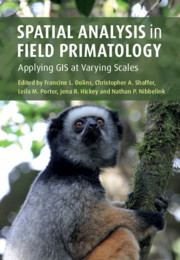Book contents
- Spatial Analysis in Field Primatology
- Spatial Analysis in Field Primatology
- Copyright page
- Dedication
- Contents
- Contributors
- Acknowledgments
- 1 Why Place Matters, and its Use in Primate Behavioral and Ecological Research
- Part I GPS for Primatologists
- Introduction
- 2 Fundamentals of GIS and GPS
- 3 “Next-Gen” Tracking in Primatology
- 4 The Ethical Implications, and Practical Consequences, of Attaching Remote Telemetry Apparatus to Macaques
- 5 Processing Geospatial Data in R
- 6 Estimating Travel Distance and Linearity of Primate Routes
- Part II GIS Analysis in Fine-Scale Space
- Part III GIS Analysis in Broad-Scale Space
- Index
- Plate Section (PDF Only)
- References
3 - “Next-Gen” Tracking in Primatology
Opportunities and Challenges
from Part I - GPS for Primatologists
Published online by Cambridge University Press: 29 January 2021
- Spatial Analysis in Field Primatology
- Spatial Analysis in Field Primatology
- Copyright page
- Dedication
- Contents
- Contributors
- Acknowledgments
- 1 Why Place Matters, and its Use in Primate Behavioral and Ecological Research
- Part I GPS for Primatologists
- Introduction
- 2 Fundamentals of GIS and GPS
- 3 “Next-Gen” Tracking in Primatology
- 4 The Ethical Implications, and Practical Consequences, of Attaching Remote Telemetry Apparatus to Macaques
- 5 Processing Geospatial Data in R
- 6 Estimating Travel Distance and Linearity of Primate Routes
- Part II GIS Analysis in Fine-Scale Space
- Part III GIS Analysis in Broad-Scale Space
- Index
- Plate Section (PDF Only)
- References
Summary
Why would you ever want to rely on electronic sensors when you can collect rich data like these by watching wild primates as they go about their daily lives? Compared to other mammalian species, primates are quite amenable to observational study; most species are diurnal and habituate quickly to the presence of human observers, allowing researchers to directly record data on their behaviors, movements, and interactions. Because, as primatologists, we can directly observe the behavior of our study animals in their natural habitats, we have never relied as heavily on telemetry (i.e., remote data collection) as scientists studying the behavior and ecology of other wild animals. Thus, before launching into specifics about how to GPS-track primates, it is worth asking why (or when) it would ever be worth the expense and the risk (to both the health of the study animal and the researcher) to catch and tag a primate with an electronic monitoring device. There are at least four distinct answers to this question.
- Type
- Chapter
- Information
- Spatial Analysis in Field PrimatologyApplying GIS at Varying Scales, pp. 42 - 63Publisher: Cambridge University PressPrint publication year: 2021
References
- 1
- Cited by



